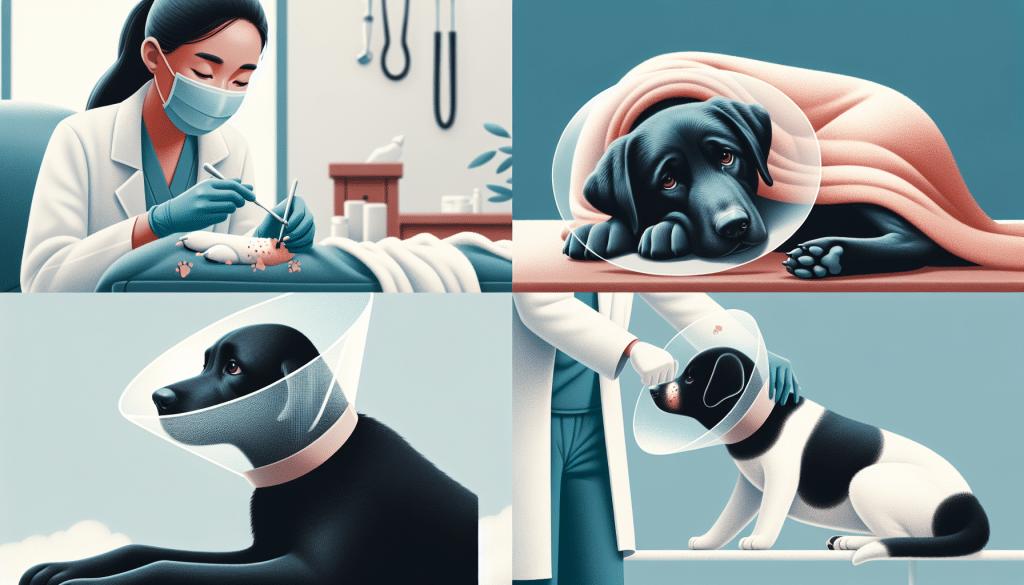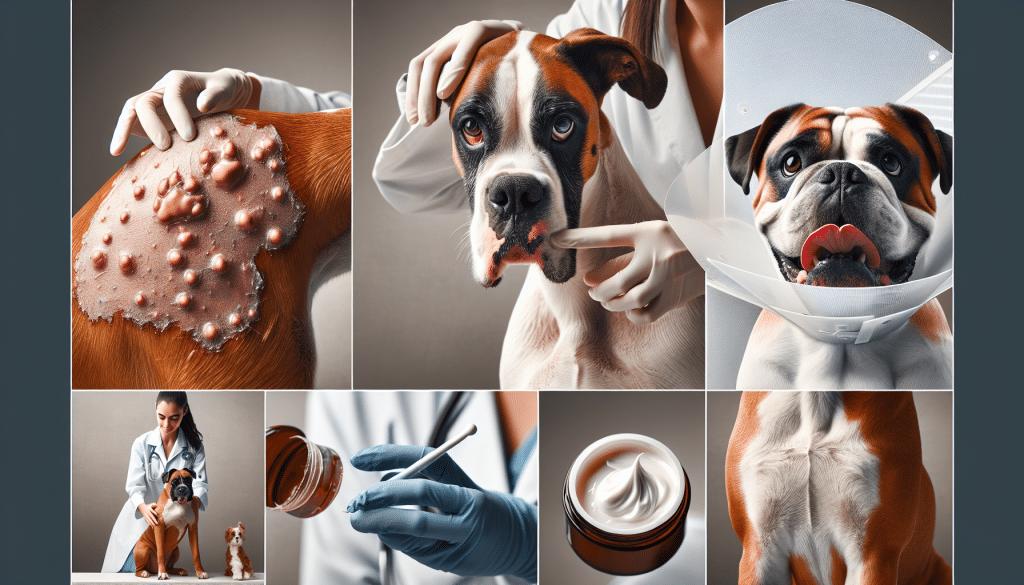So, your furry friend has developed a hot spot, huh? Don’t worry; we’ve got you covered. In this article, we’re going to give you the lowdown on how to effectively treat a hot spot on your dog. Whether it’s caused by allergies, insect bites, or excessive licking and scratching, these irritated and inflamed patches of skin can be a real bother for your pooch. But fear not, because with some simple steps and a little TLC, you can help your pup find relief and get back to wagging that tail in no time.
Understanding the Hot Spots on Dogs
Hot spots, also known as Acute Moist Dermatitis, are a common skin condition that can affect dogs of all ages and breeds. These are localized areas of skin inflammation and infection that can be quite uncomfortable for your furry friend. To effectively manage and treat hot spots, it is essential to understand their causes, identify their first signs, and provide appropriate home care. In more severe cases, seeking veterinary help becomes necessary. Once treated, it is important to continue post-treatment care at home and take preventive measures to avoid future hot spots. This comprehensive guide will cover all aspects of hot spots in dogs, from their definition to the various treatment options available, and provide useful tips on preventing and managing these pesky skin issues.

Defining Hot Spots (Acute Moist Dermatitis)
Hot spots, also referred to as Acute Moist Dermatitis, are localized areas of skin inflammation and infection. They are typically characterized by redness, swelling, and oozing. Hot spots can occur anywhere on a dog’s body but are most commonly found on the head, neck, and hips. These skin lesions can be extremely uncomfortable and can cause your dog to scratch, lick, or bite at the affected area, further worsening the condition. If left untreated, hot spots can quickly spread and become more severe, leading to more intense itching, hair loss, and the development of open sores.
Causes of Hot Spots on Dogs
There are several factors that can contribute to the development of hot spots on dogs. The most common causes include:
- Moisture: Excessive moisture, such as swimming or bathing, can create an ideal breeding ground for bacteria, leading to hot spot formation.
- Allergies: Dogs with allergies, particularly food or environmental allergies, are more prone to developing hot spots.
- Flea Infestations: Fleas can cause intense itching and irritation, prompting dogs to scratch and damage their skin, creating an ideal environment for hot spots to develop.
- Poor Grooming: Dogs with long or matted fur are more susceptible to hot spots as moisture can become trapped against their skin.
- Skin Irritation or Injury: Any type of skin irritation or injury, such as from insect bites, scratching, or rubbing against rough surfaces, can trigger the development of a hot spot.
Understanding the underlying cause of hot spots is crucial for effective treatment and prevention strategies.

Identifying the Types of Hot Spots Based on Severity
Hot spots can vary in severity, from mild to severe. Recognizing the type of hot spot your dog has is essential for appropriate treatment. Here are the different types of hot spots based on severity:
-
Mild Hot Spots: Mild hot spots are characterized by redness, slight swelling, and mild itching. The affected area may be moist, but there is minimal discharge or oozing.
-
Moderate Hot Spots: Moderate hot spots exhibit increased redness, swelling, and oozing. The affected area may also be accompanied by hair loss and intense itching.
-
Severe Hot Spots: Severe hot spots are characterized by extensive redness, swelling, discharge, and crusting. The affected area may have a foul odor and be extremely painful for your dog. Severe hot spots often require immediate veterinary attention for proper treatment.
Identifying the severity of the hot spot will help determine the appropriate course of action to alleviate your dog’s discomfort and promote healing.
Identifying First Signs of Hot Spots
Early detection is crucial in effectively treating hot spots on dogs. By recognizing the initial signs, you can intervene early, preventing the condition from worsening. Here are the first signs to look out for:
Noticing Unusual Scratching or Licking
If you notice your dog excessively scratching or licking a specific area, it could be an early sign of a hot spot. Pay close attention to these behaviors and inspect the area for any redness or inflammation.
Detecting Patches of Red, Inflamed Skin
Hot spots often appear as areas of red, swollen, and irritated skin. These patches may be moist or oozing, and your dog may exhibit discomfort when touched or when trying to scratch the affected area.
Sensing Restlessness in Your Dog
Hot spots can be incredibly itchy and uncomfortable for your dog. If you notice your furry friend becoming restless, pacing, or unable to settle, it may be a sign that they are experiencing discomfort.
Spotting Hair Loss or Sores
The continuous scratching, licking, and biting on the affected area can lead to hair loss and the development of sores. If you notice patches of missing fur or open wounds, it may indicate the presence of a hot spot.
Being vigilant and proactive in identifying these initial signs can help you address hot spots early on, preventing further complications.

Initial Home Care for Hot Spots
Providing initial home care for hot spots is essential in managing the condition and promoting healing. Here are some steps you can take to provide immediate relief to your dog:
Trimming the Hair Around the Hot Spot
To allow proper airflow and prevent further moisture accumulation, carefully trim the hair around the hot spot using grooming scissors or clippers. Be cautious not to cut the skin or exacerbate the irritation.
Gently Cleaning the Hot Spot
Using a mild, pet-safe antiseptic or a gentle, diluted solution of hydrogen peroxide, clean the hot spot. Gently pat the area dry with a clean towel, ensuring you don’t rub or irritate the inflamed skin further.
Preventing the Dog from Scratching the Area
Prevent your dog from scratching or biting at the hot spot by using an Elizabethan collar (E-collar) or a specialized pet garment that covers the affected area. This will help minimize further damage to the skin and promote healing.
By following these initial home care steps, you can help alleviate your dog’s discomfort and create an environment conducive to healing.
When to Seek Veterinary Help
While mild hot spots can often be managed at home, it is crucial to know when to seek veterinary help. Some hot spots may require professional care, especially if they exhibit severe symptoms. Here are some signs that indicate the need for veterinary intervention:
Identifying Severe Symptoms Requiring Professional Care
If the hot spot is extensive, extremely painful, foul-smelling, or accompanied by a high fever, it is essential to seek veterinary help immediately. These severe symptoms may indicate a deeper infection that requires medical attention.
Dangers of Untreated Severe Hot Spots
Untreated severe hot spots can lead to further complications, such as the spread of infection, abscess formation, and the development of secondary skin issues. The bacteria present in the hot spot can also enter the bloodstream, increasing the risk of systemic infection.
Understanding the Role of a Veterinarian in Treating Hot Spots
Veterinarians play a crucial role in diagnosing and treating hot spots. They can provide a proper diagnosis, prescribe appropriate medications, and recommend treatment options tailored to your dog’s specific condition. Seeking professional help ensures your dog receives the necessary care to recover quickly and avoid potential complications.
It is always better to err on the side of caution and consult your veterinarian if you have any doubts about the severity or management of your dog’s hot spots.
Understanding Veterinary Treatment Options
When it comes to treating hot spots, veterinarians have several options at their disposal. These treatment options aim to alleviate your dog’s discomfort, promote healing, and address any underlying causes. Here are some common veterinary treatment options for hot spots:
Introduction to Steroid Injections
Steroid injections can help reduce inflammation and relieve itching associated with hot spots. These injections are typically administered by a veterinarian and can provide quick relief for your dog.
Using Oral and Topical Antibiotics
To combat infection in more severe hot spots, veterinarians may prescribe oral or topical antibiotics. These medications help eliminate the bacteria, preventing the infection from spreading and promoting the healing process.
Understanding the Use of E-Collar
An Elizabethan collar (E-collar) is often recommended to prevent your dog from further damaging the hot spot through scratching or licking. E-collars are available in different sizes and can be adjusted to fit comfortably around your dog’s neck.
It is crucial to follow your veterinarian’s recommendations and adhere to the prescribed treatment plan to ensure optimal results for your dog’s hot spot.
Post-Treatment Care at Home
Once your dog has received veterinary treatment for their hot spot, it is essential to continue providing proper care at home. Here are some post-treatment care tips to promote healing and prevent a recurrence:
Maintaining the Cleanliness of the Affected Area
Regularly clean the affected area with a pet-safe antiseptic or as per your veterinarian’s instructions. Keeping the hot spot clean and dry will aid in healing and minimize the risk of infection.
Ensuring Regular Follow-up Veterinary Check-ups
Schedule follow-up appointments with your veterinarian as directed. Regular check-ups allow your veterinarian to monitor the progress of the hot spot and make any necessary adjustments to the treatment plan.
Administering Prescribed Medications Properly
If your dog has been prescribed medications, such as oral antibiotics or topical creams, follow the instructions provided by your veterinarian. Administer the medications as directed to ensure their effectiveness in treating the hot spot.
By diligently following the post-treatment care guidelines provided by your veterinarian, you can optimize the healing process and reduce the chances of recurrence.
Preventing Future Hot Spots
Prevention is always better than cure when it comes to hot spots. Taking proactive measures to prevent their occurrence can save your dog from discomfort and potential complications. Here are some important steps you can take to prevent future hot spots:
Adopting Proper Grooming Habits
Regular grooming is essential to maintain your dog’s skin health. Brushing your dog’s coat regularly helps prevent matting and removes any debris or parasites that can cause irritation. Additionally, ensure your dog’s coat is kept clean and dry, especially after swimming or bathing.
Feeding a Balanced Diet to Your Dog
Proper nutrition plays a significant role in your dog’s overall health, including skin health. Provide a balanced diet that meets your dog’s specific nutritional needs. Consult with your veterinarian to determine the best diet for your furry friend.
Recognizing and Avoiding Trigger Allergens
If your dog has allergies, identifying and avoiding the trigger allergens is crucial in preventing hot spots. Common allergens include certain foods, environmental factors like pollen, and fleas. Work with your veterinarian to determine the allergens affecting your dog and develop a plan to minimize exposure.
Promoting Mental Well-being of Your Dog
Stress and anxiety can potentially contribute to the development of hot spots. Promote your dog’s mental well-being by providing regular exercise, mental stimulation, and a calm and structured environment. Create a safe space for your dog where they can relax and feel secure.
By incorporating these preventive measures into your dog’s routine, you can significantly reduce the likelihood of hot spots occurring in the future.
Using Natural Remedies for Hot Spots
In addition to veterinary treatment, some pet owners may be interested in using natural remedies to support the healing process of hot spots. While natural remedies can provide soothing effects, it is important to consult with your veterinarian before using them. Here are a few commonly used natural remedies for hot spots:
Understanding the Role of Aloe Vera
Aloe vera gel is known for its soothing properties and can be applied topically to hot spots. It can help reduce inflammation and promote healing. However, it is crucial to ensure you are using a pet-safe aloe vera gel without any added chemicals or preservatives.
Using Black Tea Bags
Black tea bags soaked in warm water can be applied as a compress on hot spots. The tannins present in black tea have natural astringent properties that can help dry out the hot spot and provide relief.
Evaluating the Effectiveness of Natural Remedies
While natural remedies can offer relief, they may not be sufficient to treat severe hot spots. It is important to monitor your dog’s hot spots closely and consult with your veterinarian if there is no improvement or if the condition worsens.
Remember, natural remedies should always be used under the guidance of a veterinarian to ensure their safety and effectiveness for your dog.
Debunking Common Myths about Hot Spots
There are several myths surrounding hot spots on dogs. It is important to separate fact from fiction to better understand and manage these skin issues. Let’s debunk some common myths associated with hot spots:
Breaking the Myth: Hot Spots Are Not Contagious
Hot spots are not contagious between dogs. They are localized skin infections and do not spread through direct contact or exposure.
Breaking the Myth: Not All Skin Issues Are Hot Spots
While hot spots are a common skin issue, not all skin problems on dogs are hot spots. Other skin conditions like allergies, fungal infections, or eczema can have similar symptoms and require different treatment approaches.
Breaking the Myth: Hot Spots Are Not Always Self-Inflicted
While incessant scratching or licking can contribute to the development of hot spots, they can occur due to various causes, including allergies, flea infestations, or irritations from external factors. It is important to identify the underlying cause to effectively treat and prevent hot spots.
By debunking these myths, you will have a better understanding of hot spots and can focus on appropriate management and treatment strategies.
Effect of Hot Spots on Different Breeds
While hot spots can occur in any breed, certain breeds may be more prone to developing them. It is important to recognize the unique signs of hot spots in different breeds and adapt treatment approaches accordingly. Here are some factors to consider:
Identifying Breeds Prone to Hot Spots
Breeds with thick double coats, such as Golden Retrievers, German Shepherds, or Labrador Retrievers, may be more susceptible to hot spots due to increased moisture and limited airflow against their skin.
Recognizing Unique Signs of Hot Spots in Different Breeds
Different breeds may exhibit variations in the appearance and location of hot spots. For example, in breeds with wrinkled skin like Bulldogs or Shar-Peis, hot spots may occur in skin folds, requiring extra care to keep the area clean and dry.
Adapting Treatment Approaches for Different Breeds
Certain breeds may require specific treatment approaches based on their unique characteristics. Consulting with a veterinarian experienced with the specific breed can help ensure the most effective treatment protocol is followed.
Understanding the breed-specific considerations for hot spots allows for targeted care and better management of this condition.
In conclusion, understanding the causes, identifying the signs, providing initial home care, and seeking veterinary help when necessary are key to effectively managing and treating hot spots on dogs. By following proper post-treatment care and taking preventive measures, you can minimize the chances of hot spots occurring in the future. Remember, your veterinarian can provide expert guidance and support throughout this process, ensuring the health and well-being of your furry friend. So, stay vigilant, be proactive, and prioritize your dog’s skin health to keep them happy and comfortable.



